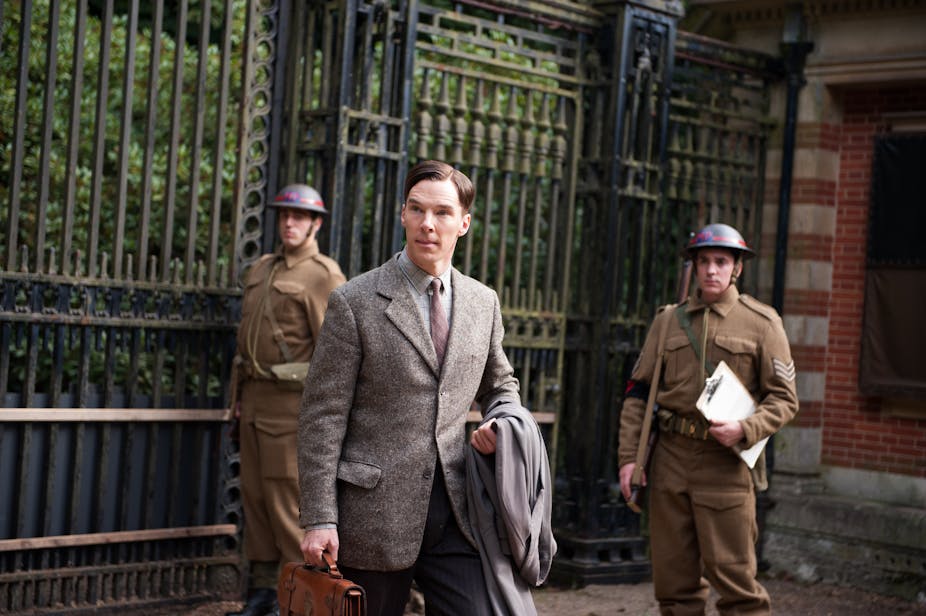The Imitation Game has scooped up eight Oscar nominations this year, including the coveted Best Picture. Since its release in autumn 2014 the film has attracted widespread positive critical appraisal and commercial success.
Its story of British mathematical genius Alan Turing who broke the German Enigma codes in World War II is now widely known. Equally well-known, at least in Britain, is the fact that Turing was gay, a homosexual, to use the terminology of the day, and that he reputedly committed suicide in 1954 at the age of 41 after receiving hormone therapy as a result of a conviction in 1952 for gross indecency. He was posthumously pardoned for his “offence” – in 2013.
The film has also attracted criticism in some quarters for underplaying Turing’s homosexuality, and foregrounding a (non-sexual) relationship with fellow mathematician, Joan Clarke, played by British actress Keira Knightley. But besides such personal details, the film’s more general portrayal of homosexual life in the 1940s and 1950s does stand up to critical scrutiny.
Wartime liaisons
Blackout during wartime afforded opportunities for homosexual liaisons that many wouldn’t have experienced before. Men could find each other under the cover of complete darkness and, no doubt, because the authorities had more pressing matters to hand.
However, homosexuality remained illegal under the hated “Labouchère” amendment to the Criminal Law Amendment Act in 1885, which outlawed “gross indecency” between men. This was the law that sent Oscar Wilde to jail for two years of hard labour – and which was used to prosecute Turing. It was widely regarded as a blackmailer’s charter. And so although the scene in which Turing is blackmailed by the Russian spy John Cairncross may not be historically correct, it is certainly a good reflection on the times. In this sense the film captures the perpetual threat that homosexual men had to live with.
The war years may have been relatively kind to homosexual men but prosecutions for sexual crimes increased in the period immediately after the war, reaching a peak in 1961. Police tactics were often rebarbative and generated genuine fear. The police pursuit of Turing in The Imitation Game provides an insight into the importance the police gave to prosecuting homosexual “crimes”.
Men often went to great lengths to cover their tracks. A groundbreaking study by Michael Schofield, published in 1960, revealed the diversity of homosexual lives in the period and the myriad ways they negotiated through the undeniable difficulties they often faced. In his autobiography, London journalist Peter Wildeblood, who was another high profile victim of homophobic laws and police tactics, claimed it was necessary for him to watch every word he spoke, every gesture that he made. Turing’s sexual discreetness in The Imitation Game is an accurate representation of how most homosexual men had to behave.
Tolerance, conviction
There has been a growing appreciation in queer academia that there was often tolerance and acceptance of men leading homosexual lives at a domestic level, not just from immediate families and local communities, but also from landlords and landladies. There was widespread public disquiet at these draconian laws. Sympathy for another famous victim caught up in a police sting saw actor John Gielgud receive a standing ovation when he returned to the stage in Liverpool after his conviction for gross indecency in 1953 secured lurid headlines in the newspapers.
But while there may have been a certain degree of tolerance toward homosexuality, especially for those men who lived “respectable” and quiet lives, criminal proceedings remained a real threat for many. Patrick Higgins’s review of court cases in Heterosexual Dictatorships (1996) shows that homosexual lives continued to be led across the breadth of the country throughout the 1950s, albeit in the shadow of the law, and involved men from all walks of life. For example, the court records show a case from Rotherham, Yorkshire, where 17 unskilled and semi-skilled men pleaded guilty to 41 charges of homosexual acts. In the same year in Barnsley, 12 men confessed to homosexual acts. Prosecution was widespread.
Despite, or rather because of the occasional high-profile trial and the number of less famous prosecutions, homosexuality was largely pushed into the dark recesses of society. Paradoxically, its very invisibility acted as a cloak for those seeking liaisons with other men. In practice no-one suspected other people of being homosexual. Again, the presumption that Turing could not possibly be gay comes across in the film if only as a minor sub-plot, but it strikes a true chord.
The Imitation Game may play fast and loose with a great deal of historical accuracy, as films are entitled to do. But the artistic portrayal speaks to a greater truth. In the light of what we know about homosexual life at the time, The Imitation Game mostly gets it right.

